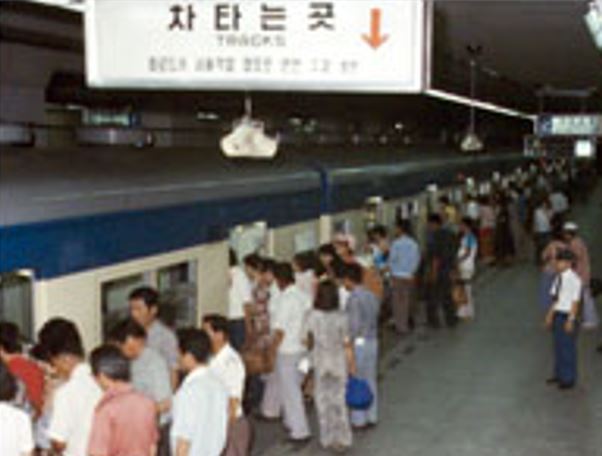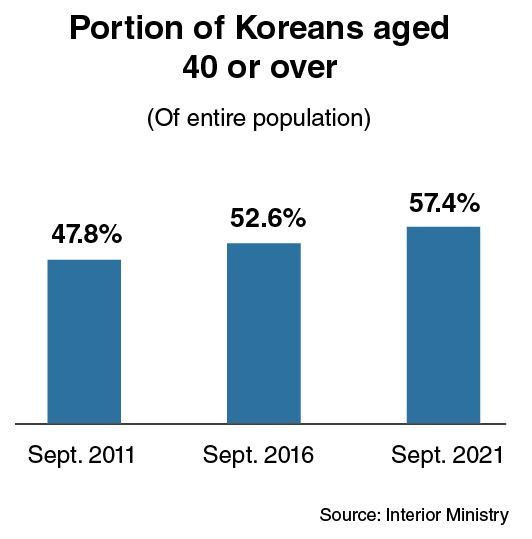[News Focus] Share of Koreans aged 40 or over surges
In a decade, people aged over 39 up from 47% to 57%
By Kim Yon-sePublished : Oct. 7, 2021 - 15:11

SEJONG -- The 40-and-older population in South Korea has surged by nearly 10 percentage points in a decade in terms of their percentage of the entire population, government data showed.
According to the Ministry of Interior and Safety, the number of those aged 40 or above posted 29.67 million as of September. This took up 57.4 percent of the total population of 51.66 million.
This was a 9.6 percentage point increase from the 47.8 percent in September 2011 for the age groups -- from those in their 40s to centenarians.
At the current pace of demographic growth in this aged society, 3 in 5 Koreans -- or 60 percent of the population -- will likely be aged 40 or over by 2023 or 2024.
According to the Ministry of Interior and Safety, the number of those aged 40 or above posted 29.67 million as of September. This took up 57.4 percent of the total population of 51.66 million.
This was a 9.6 percentage point increase from the 47.8 percent in September 2011 for the age groups -- from those in their 40s to centenarians.
At the current pace of demographic growth in this aged society, 3 in 5 Koreans -- or 60 percent of the population -- will likely be aged 40 or over by 2023 or 2024.

Koreans in their 50s (8.61 million), 40s (8.18 million) and 60s (7.09 million) ranked first, second and third, respectively, among all age groups last month. They far outstripped those in their 30s at 6.74 million, those in their 20s at 6.7 million and those in their 10s at 4.72 million.
Further, the tally for babies and children aged under 10 stayed at 3.8 million, a similar figure to those in their 70s at 3.7 million.
Given that the gap between the two age groups sharply narrowed in only a year -- from 347,006 in September 2020 to 104,112 in September 2021, those aged 70-79 are likely to overtake those under 10 by as early as in the first quarter of 2022.
Amid the world’s record-low fertility rates and fast-expanding lifespan of Koreans, the share of people aged 50 or over topped the 40 percent mark (40.09 percent) for the first time in June 2020. The count went up further to 41.6 percent as of September 2021.
Meanwhile, the tally for Koreans aged 65 or over -- who are classified as seniors -- posted 8.75 million last month.
The percentage of those aged 65 or above is poised to reach the 17 percent mark (16.9 percent as of September) for the first time since the nation has been compiling the data. This means 1 in 6 Koreans are seniors at the current stage.
In contrast, the portion of those under 10 fell below the 12 percent mark for the first time at 11.9 percent.
Interior Ministry data showed that the average age of Koreans reached to an all-time high of 43.6 (42.4 for men and 44.7 for women) as of last month, compared with 38.5 in September 2011. Korean’s average age reached the 40-year mark in October 2014 for the first time.
By region, South Jeolla Province recorded the highest average age, at 47.3. North Gyeongsang Province ranked second at 46.7, followed by Gangwon Province at 46.3, North Jeolla Province at 46 and Busan at 45.4.
Meanwhile, Korea’s population declined by 2,028 on-month to 51.667 million, as of September. It was at its lowest point in five years since September 2016, when the figure was 51.664 million.
After peaking at 51.85 million in November 2019 -- which could possibly remain the all-time high in Korean history at least for decades to come -- the figure continued to drop for the 22nd consecutive month starting from December 2019, during which the population lost 183,739 in less than two years.
Last month, Seoul took the lead in the decrease as the number of residents dropped by 7,971 on-month. The capital’s population dropped to the level of that of the mid-1980s at 9.54 million.
South Gyeongsang Province placed second with a slide of 3,102 to 3.31 million, followed by South Jeolla Province down 2,663 to 1.83 million. North Gyeongsang Province and North Jeolla Province shed 1,910 and 1,366, respectively.
Ten, including Busan and Daegu, out of the 17 major regions suffered an on-month retreat in demographic figures.
Further, the tally for babies and children aged under 10 stayed at 3.8 million, a similar figure to those in their 70s at 3.7 million.
Given that the gap between the two age groups sharply narrowed in only a year -- from 347,006 in September 2020 to 104,112 in September 2021, those aged 70-79 are likely to overtake those under 10 by as early as in the first quarter of 2022.
Amid the world’s record-low fertility rates and fast-expanding lifespan of Koreans, the share of people aged 50 or over topped the 40 percent mark (40.09 percent) for the first time in June 2020. The count went up further to 41.6 percent as of September 2021.
Meanwhile, the tally for Koreans aged 65 or over -- who are classified as seniors -- posted 8.75 million last month.
The percentage of those aged 65 or above is poised to reach the 17 percent mark (16.9 percent as of September) for the first time since the nation has been compiling the data. This means 1 in 6 Koreans are seniors at the current stage.
In contrast, the portion of those under 10 fell below the 12 percent mark for the first time at 11.9 percent.
Interior Ministry data showed that the average age of Koreans reached to an all-time high of 43.6 (42.4 for men and 44.7 for women) as of last month, compared with 38.5 in September 2011. Korean’s average age reached the 40-year mark in October 2014 for the first time.
By region, South Jeolla Province recorded the highest average age, at 47.3. North Gyeongsang Province ranked second at 46.7, followed by Gangwon Province at 46.3, North Jeolla Province at 46 and Busan at 45.4.
Meanwhile, Korea’s population declined by 2,028 on-month to 51.667 million, as of September. It was at its lowest point in five years since September 2016, when the figure was 51.664 million.
After peaking at 51.85 million in November 2019 -- which could possibly remain the all-time high in Korean history at least for decades to come -- the figure continued to drop for the 22nd consecutive month starting from December 2019, during which the population lost 183,739 in less than two years.
Last month, Seoul took the lead in the decrease as the number of residents dropped by 7,971 on-month. The capital’s population dropped to the level of that of the mid-1980s at 9.54 million.
South Gyeongsang Province placed second with a slide of 3,102 to 3.31 million, followed by South Jeolla Province down 2,663 to 1.83 million. North Gyeongsang Province and North Jeolla Province shed 1,910 and 1,366, respectively.
Ten, including Busan and Daegu, out of the 17 major regions suffered an on-month retreat in demographic figures.


















![[Today’s K-pop] Treasure to publish magazine for debut anniversary](http://res.heraldm.com/phpwas/restmb_idxmake.php?idx=642&simg=/content/image/2024/07/26/20240726050551_0.jpg&u=)